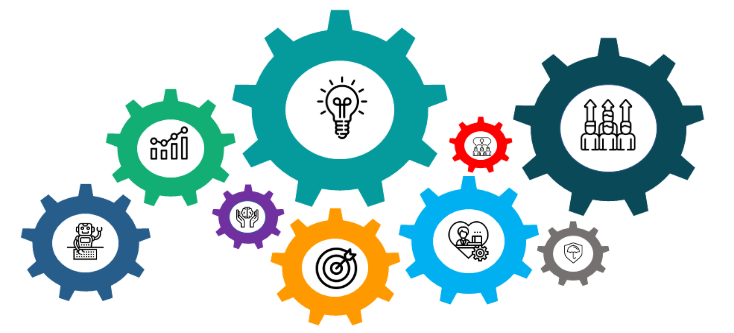Sign Up for Our
Updates
Business Intelligence vs Process Mining: What's the Difference?
If you’re confused about the difference between Business Intelligence and Process Mining, you’re not alone. Many people I’ve talked with are fairly familiar with Business Intelligence but aren’t exactly sure what Process Mining’s role is in the business operations landscape. Some even think that Process Mining and Business Intelligence are the same thing.
So, you too are wondering, what’s the difference between Business Intelligence and Process Mining? Do they solve different problems? Can they provide the same kind of value to businesses? Does your business need both, or is just one enough?
To answer these questions, let’s do a comparison to see the similarities, and more importantly, the differences between what Business Intelligence and Process Mining bring to businesses.
What is Business Intelligence?
Business Intelligence (BI) is a set of practices and tools that transform raw business data into meaningful information to help businesses in decision-making. The goal of Business Intelligence is to identify inefficiencies and problems in business operations and opportunities in order to increase profit and business growth.
There are many ways to carry out BI with dozens of BI technologies and softwares that can graph, chart, and provide reports on data for analysis. Data from both systems and employees is collected and stored in a data warehouse where datasets can later be accessed for the analysis process.
What is Process Mining?
Process Mining discovers, monitors, and optimises business processes. Process Mining automatically discovers a process model from a company’s systems data. After the process model has been discovered, Process Mining drills down into activities within the process and executes deep level analyses to discover process behaviour and inefficiencies like bottlenecks and reworks, performs conformance checking, and discovers roles in a process, providing actionable insights to support informed decision-making for process improvement.
Business Intelligence and Process Mining: the Comparison
Though BI doesn’t focus solely on business processes, it does monitor and analyse critical business processes as part of its operational excellence strategy.
Process Mining and BI do share a few things in common. Both deal with managing and analysing business data to provide actionable insights that support business decision-making. BI and Process Mining usually start from the same data that have been stored in a data warehouse. And the critical business processes Process Mining is usually used to analyse are often also analysed with BI (we’ll go into greater detail below).
But despite having similar goals and dealing with the same processes, they start to diverge in function and scope.
It's All About the Data
Data is the starting point for both BI and Process Mining. They both benefit businesses by bringing cold, hard data to the analysis phase which is ideal for understanding exactly what has and hasn’t happened in your business operations. But the datasets used, the depth of analysis, and the results they yield make for different types of insights.
What Gets Analysed?
BI and Process Mining will often analyse the same processes to gain insight but the level of analysis is different. BI’s analysis compared to Process Mining is high level, more concerned with measuring if a process is meeting productivity and efficiency standards or meeting customer needs and satisfaction. Contextual data is essential for BI which looks for business trends and problems related to KPI alignment in sales, marketing, and other critical operations. It’s interested in analysing its critical business processes to understand if there are problems in the process that affect business operations as a whole.
Process Mining focuses entirely on the discovery and analysis of end-to-end business processes and, therefore, is only concerned with the subset of event data (event logs) relevant to a particular business process. It uses the data to automatically derive the end-to-end process, defining each activity, known or unknown, to create the process workflow. Process Mining then performs a drill down analysis into each activity to look for bottlenecks, reworks, deviations and other inefficiencies that increase time and costs in the process.
Getting to the Root of the Problem
BI doesn’t perform a root cause analysis to understand why there was a change in the expected process behaviour. This is largely because BI doesn’t start from mapping the process model, but rather assumes that the process flow along with all the activities that compose it are known. BI analyses the performance of the process it believes is taking place and studies the process through a heavy contextual data perspective. In other words, it does a great job of telling you what the problem is, but not why it’s happened.
The transparency Process Mining brings to entire processes means it’s not only possible to locate problems within the process but also perform root cause analyses to discover where the problem originates, who is involved and more importantly why it's happening by revealing bottlenecks, reworks, and deviations. It can also show the impact the problem has on other activities in the process.
Process Mining provides a much greater advantage to businesses who don’t have time to interrogate employees to define the problem and discuss why the problem occurs. It’s concerned only with event logs and, therefore, doesn’t require departmental interviews. This is because Process Mining attempts to find out the actual process flow evidenced by the data, not how individuals believe the process flow to be nor how the process flow should be.
Types of Insights
BI tools show trends, patterns, and correlations between sets of data. Once the analysis is completed, it’s up to the business analysts to decide how to interpret that information to derive insights. If a process isn’t meeting a KPI, the analyst has to decide not only why the KPI isn’t being met, but what action to take to get the process back into KPI alignment.
Process Mining insights, on the other hand, are almost always actionable. That is, Process Mining’s insights don’t leave much to interpretation. Where BI can identify that a process is not meeting an expected KPI due to, with Process Mining you can clearly identify the bottleneck that wastes the most time and act to remove. If you discover your bottleneck is created by a high number of event cases that involve a rework for a particular activity, the analysis itself provides the insight—the rework should be eliminated.
But it’s not just past events that Process Mining can give insight into. Process Mining solutions, like myInvenio, that include advanced capabilities like Digital Twin of an Organisation are able to test change initiatives before implementation to show you what your processes will look like in the future once actions are taken.
Improved Insights with Digital Twin of an Organization
Process discovery is the phase of Process Mining on which all other analyses depend on. The accuracy and precision of the model will determine the level of analysis and subsequently the depth of the insights that can be obtained.
Digital Twin of an Organisation (DTO) is the latest advancement in Process Mining technology that creates ultra precise and dynamic virtual process models. It’s possible to get such a precise model because DTO provides additional information that traditional Process Mining alone can’t get. This information gives you a clearer, more detailed view of your process for greater ability to act quickly, implement changes relevant to the current market, and guarantee you’re adding value to your process when you implement changes.
Process Mining tools that can create a DTO offer many capabilities beyond traditional Process Mining in order to obtain the additional data to create a precise and dynamic process model.
Task Mining
Task Mining is a recent capability that makes up part of a DTO. Task Mining is the discovery, monitoring, and analysis of user interaction data. It captures user interaction data directly from a user’s desktop to record the tasks carried out by those users. After, the collected data is loaded into Process Mining software that uses an algorithm to automatically generate an event log for that data which can be analysed for insights.
The user interaction data collected by Task Mining was previously considered untapped data. Now thanks to this new capability, you can get a more accurate view of your end-to-end process with more visibility to find inefficiencies and opportunities for improvement, like automation.
Business Rule Mining
Process Mining has become increasingly advanced in its detective work to discover what makes a process tick. Business Rules Mining automatically derives business rules according to your business contextual data.
When contextual data is integrated into the process analysis with event data, you can discover business rules to find correlations between process behaviour and those rules that show not only the probability of a process following a specific path but also why it follows that path.
Simulation
An advanced Simulation tool can run What-If scenarios of your As-Is process to automatically create a To-Be process model. It can also generate an event log with simulated cases based on the real historical data. When you add in the discovered business rules, it’s even possible to test To-Be process performance according to your business’s seasonality trends. Once a simulation is configured, Process Mining performs an analysis on the To-Be process to show expected future performance and reliable ROI estimations.
Business Intelligence vs Process Mining for Automation Implementation Strategies
Automation is a growing trend for process improvement and overall business operational efficiency. With the rise of automation, businesses need insight into where to implement automation, what the results will be post implementation, and a way to continuously monitor performance.
Currently, there is no BI tool capable of identifying the ideal tasks that would benefit the most from being automated. There is also a high risk in automating random tasks in a process without a good understanding of how they measure up to performance metrics or if the tasks being automated are the ones creating the problems in the first place. The costs of developing and implementing bots without first analysing potential impact can end up costing a company even more in expenses and create confusion and frustration among company employees.
Process Mining tools that possess DTO capabilities provide valuable insights that reduce pre-automation effort and support rapid RPA scale-up. Process Mining analyses user interaction data collected from Task Mining to show how user tasks impact other activities in the process and the effect those impacts have on the whole end-to-end process. This insight is the starting point when evaluating which tasks will bring the most improvement when automated. You can then create what-if scenarios with Simulation to include the number bots you want to implement and customise the settings, like how many hours you want a bot to run per day and the number of staff that will remain for the activity. Comparing your As-Is process with the To-Be process with automation will reveal important insights into expected ROI and changes in lead time. Process Mining can also monitor bot performance post implementation and analyse the new workflow which BI can use for reporting.
The Conclusion
Process Mining is a beneficial and necessary complement to Business Intelligence. When processes are continuously discovered and analysed, you increase your understanding of why problems happen within your process and gain better insight into how you can resolve them and improve results from automation initiatives. Process Mining’s goal serves Business Intelligence’s purpose to drive continuous company-wide improvement.




.jpg)